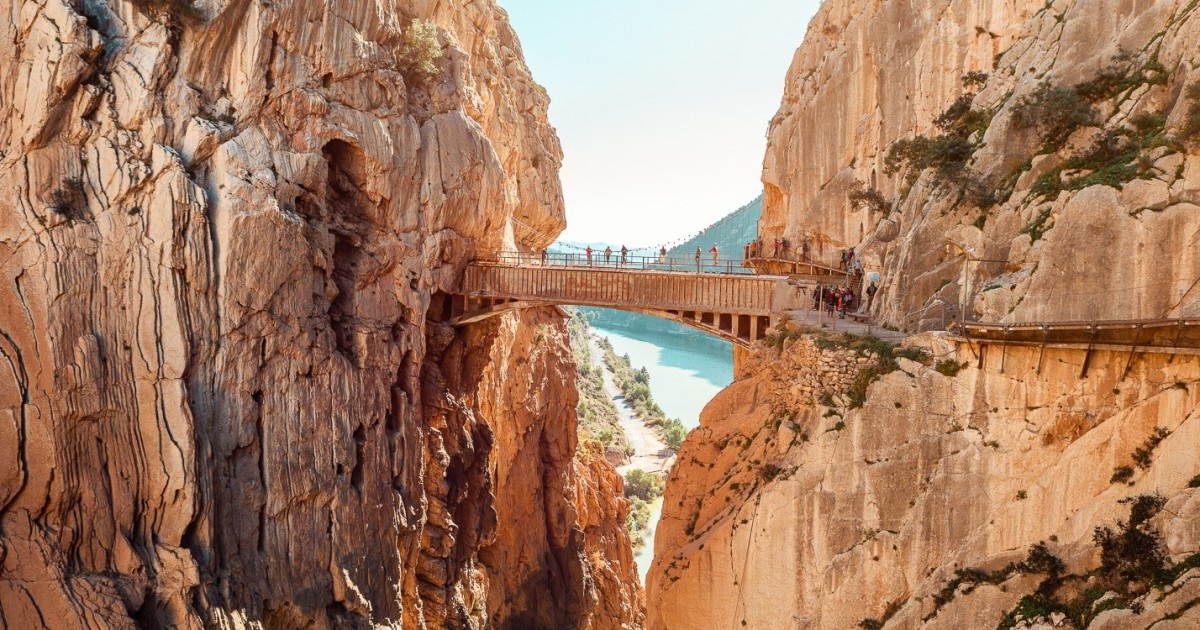
Caminito del Rey Private Hikes with Discovering Spain
Difficulty
moderate
Duration
3–4 hours
Fitness Level
Participants should be in good physical condition with comfort on narrow walkways and some steep sections.
Overview
Navigate the vertiginous Caminito del Rey with a private guide from Discovering Spain, experiencing dramatic cliffs, waterfalls, and rich local history on this unforgettable trail near Teba, Malaga.
Visita guiada en privado a Caminito del Rey
| 3 horas | Desde 8 años de edad
Select participants and date
Adventure Photos

About This Adventure
Experience the breathtaking Caminito del Rey, a stunning walkway perched over 100 meters high, nestled in the Sierra de Huma. This thrilling 7.7-kilometer hike through the Desfiladero de los Gaitanes offers spectacular views of cliffs, waterfalls, and lush forests, all while learning about the area's rich history with a private guide.
Conoce el famoso Caminito del Rey, a tan sólo una hora de la Capital. Una imponente pasarela que hace las delicias de los visitantes, gracias a su historia y naturaleza a más de 100 metros de altura.
Duración
3 horas
Qué te espera
Te proponemos realizar con nosotros un sendero de vértigo en el Desfiladero de los Gaitanes, donde encontramos el famoso Caminito del Rey, el paseo que dio a conocer el propio rey Alfonso XIII, y que hoy es visitado por miles de personas.
En la conocida Sierra de Huma, encontramos una de las rutas de senderismo más populares de España. La caminata tiene una longitud de 7,7 kilómetros y se tarda aproximadamente entre 3 y 4 horas en completarla.
Durante el recorrido con tu guía en privado, podrás disfrutar de unas vistas impresionantes de los desfiladeros, las cascadas y los bosques que rodean el camino. También podrán aprender sobre la historia y la naturaleza de la zona.
Qué se visita
-
Desfiladero de los Gaitanes. -
Caminito del Rey -
Río Guadalhorce.
Qué incluye
- Guía oficial especializado
- Tour guiado en privado
- Ticket de acceso a Caminito del Rey
Punto de encuentro
Caminito del Rey W6J6+Q4, 29550 Gobantes, Málaga
Información importante
No apta para sillas de ruedas. Ruta no accesible.
Observaciones
- Los menores de 8 años no podrán acceder a las instalaciones.
- Por motivos de seguridad o reparación la empresa se reserva la facultad de modificar el itinerario o clausurar las instalaciones, temporal o parcialmente.
- En caso de cancelación por la dirección del Caminito se devolverá al cliente el importe de las entradas y el guía, sólo se devolverá el importe del transporte en aquellos supuestos en los que no se haya producido el traslado. En cuyo caso, se propondrá una ruta alternativa, ya que esta casuística no depende de Anera Travel S.L
Adventure Tips
Wear sturdy hiking shoes
The path features uneven surfaces and metal walkways that require good grip and support.
Bring sun protection
The exposed sections of the trail offer limited shade, making sunscreen, hats, and sunglasses necessary.
Reserve your private guide early
Private tours are limited in number and fill up quickly, especially in high season.
Stay hydrated
Carry enough water, especially in warmer months, as there are no water points along the route.
Local Insights
Wildlife
- Spanish ibex often spotted on cliffs
- Birds of prey such as griffon vultures soaring overhead
History
Constructed in 1905 for hydroelectric project workers, the walkway was once notorious for its height and danger before being restored and opened to the public in 2015.
Conservation
Strict visitor limits and ongoing maintenance protect the fragile ecosystem and geological formations from degradation.
Select participants and date
Adventure Hotspots in Malaga
Recommended Gear
Hiking boots with ankle support
Provide stability and protect feet on rocky and metallic pathway surfaces.
Sun hat and sunscreen
Protect skin and eyes from intense sun during exposed sections.
summer specific
Light jacket or fleece
Layering is key for changing temperatures, especially in the shade or higher elevations.
fall specific
Reusable water bottle
Ensure hydration since no water is available along the trail.
